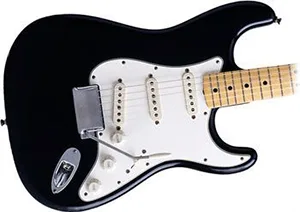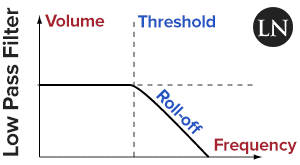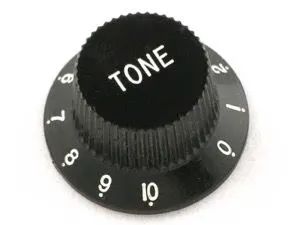There’s nothing like diving head first into a new instrument. We’re all as familiar with each various instrument as anyone else, but once you start studying one you realize how much you took for granted. What seemed obvious isn’t so clear cut. And that’s where the author of today’s question finds himself: “What does a tone knob do?“

I love these kind of questions because it shows us gaps in our content beyond the huge ones we’re still trying to cover. Our reader questions often lead to full investigations on a broader scale, and this one is no exception. If this quicker answer doesn’t satisfy your curiosity, you can read more about it and related topics in our article called ‘What is Guitar Tone?‘.
How Does a Guitar Tone Knob Work?
Question:
I’ve purchased my first guitar after years of interest and tinkering with everyone else’s instruments. Everyone, including myself, always talked about which famous guitarist had the best tone.
Now that I have an electric guitar in my hands, I’m left pondering what the tone knob actually does. I can hear the difference but can’t explain what I’m hearing or how it’s controlled. Can you explain this magic?
Thanks for your time,
Nate
Answer:
Hi, Nate. That’s a great question. Let’s take a step backwards from it to gather some context and then dive right back in. You’ll find all kinds of switches and knobs on your electric guitar. These all relate to the pickups and your overall gain. Gain is the ratio of the output to input voltages, which is a more mathematical way of saying ‘volume.’
Blade Switches
You may or may not have a blade switch, which come in various configurations from 3-way up to 5-way, meaning they have 3 or 5 settings to choose from. If you don’t have one of these switches, it’s because you have a single pickup guitar.
A 3-way switch lets you choose between using either of your two pickups alone or both together as a mixture. A 5-way blade switch will let you choose between mixing and matching three pickups.

I said all of that so I could say that your tone knob or tone knobs are affecting the characteristics of the output of the pickups. In a single pickup guitar you’ll have only one tone knob but you can have multiples depending on the number of pickups you have. Each one can be controlled individually.
What is a Tone Knob? An Equalizer…
This brings us full circle back to your original question, which can be paraphrased as “What sound characteristic does the tone knob affect and how does it actually do it?” A tone knob is controlling a potentiometer (known casually as a ‘pot’) that is acting as a low pass filter for your pickup’s output.
A low pass filter is a type of equalizer that is very easy to use and understand. What you’re doing when you twist the knob is you’re moving a threshold value up and down the frequency range. Let’s say this threshold lands on the 6 kHz frequency. A low pass filter only allows frequencies at a lower value than the threshold to pass through, which means it’s chopping out higher frequencies.

The main takeaway here is that you’re never adding warmth. You’re only achieving warmth by removing higher frequencies. People refer to warmth as the upper-lows and lower-mids on the frequency spectrum.
When you leave the tone knob at 10, you essentially have it in bypass mode where all frequencies can pass through unabated. But as you twist it down you’re gradually sliding that threshold down towards the bass region of the frequency spectrum. Any higher frequencies will quickly ‘roll-off’ in volume so they are far less noticeable.
So in a jazz band you may hear a real crisp guitar tone where they may have the tone knob at 8 to 10. A metal player may dial that down to a 7 to 9, and a southern rock player may dip down to a 5 to get a smoother, mellower tone.
Good tone Changes in Context
The question that usually comes after this one is related to needing help finding the perfect tone. You’ll develop preferences over time, but really there is no perfect tone.
It can change from song to song, which is why some players will set their volume correctly with their tone knob aimed around a 7. This way they can comfortably move up or down with their tone without affecting their volume too much while trying to hang around that 7 value.

This technique points out the reality that as you start cutting out frequencies, you’re also dropping the volume a bit. This is why some players go nuts trying to re-find the tone they dialed in last time they played. It’s elusive until you give up the quest and become all of the tones!
The proper way to create the tone you want before you start hitting your pedals and amplifier effects is to open the tone knob up to a 10 and set your volume. Go ahead and get the amount of saturation and distortion you want, then start turning the tone down until you cut out as much of the sharpness you want so your tone sounds warmer.
Now you may find you’ve lost some articulation in your playing due to cutting out the high frequencies, so you add a little tone back while bumping up the volume to compensate for the loss due to the low pass filter. Then you repeat this process with tinier steps until you’ve narrowed down on the sound you like.
You may want to write these knob values down somewhere and give the tone a name you can remember for self-reference. Hope this helps you understand the overall concept and how to use your guitar’s tone knob
Write back if needed,
Jared